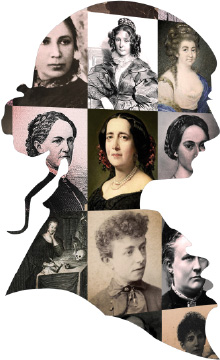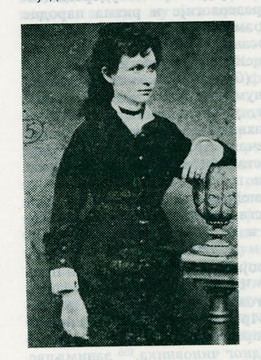Draginja Draga Gavrilović
1854–1917| Pseudonyms | Jedna učiteljica, Tvoja iskrena drugarica, Tvoja – znaš već ko, and Jedna narodna učiteljica |
|---|---|
| Date of birth | March 14, 1854 |
| Date of death | February 25, 1917 |
| Web address |
Personal situation
Draga Gavrilović was born on March 14, 1854, as the eldest child of Milan and Milanka Gavrilović, in Srpska Crnja, Banat (then a part of the Austro-Hungarian Empire). Along with Draga, Milan and Milanka had five more daughters and two sons (their son Petar and sister Darinka died very young, Petar at the age of sixteen, and Darinka at the age of three). The Gavrilović were a family of wealthy and esteemed merchants. Aside from commerce, Draga’s father held a position in the municipal administration, serving briefly as a school principal. In the household of the family, special care was taken to ensure that the children had a proper upbringing and education: Draga and her siblings, aside from Serbian, spoke German and Hungarian, played music and were well informed of all literary occurrences.
c. 1865 Draga finished primary school in Novi Sad, afterwards returning to Crnja, where she learnt “womanly” crafts and household chores.
1866–1874 A highly active movement, called the United Serbian Youth, was formed in Vojvodina. Amongst other things, it helped raise the issue of female education. In 1871, a Decree on Serbian female secondary schools was passed, allowing young women to attend classes at the Sombor School for Teachers. On the basis of this decree, other female secondary schools would be founded in the next several years (in Pančevo and Novi Sad).
1875 With his family’s reputation in mind, Draga’s father Milan decided to enroll his eldest daughter into the Sombor School for Teachers.
1875–1878 After successfully passing the entry exam, Draga enrolled in the Sombor School for Teachers in September 1875. Unfortunately, because of her poor health during her school years, Draga was often absent from class and failed to achieve academic excellence. Having finished the school in Sombor, she returned to Crnja where she started working as a teacher.
1878 She started publishing poems, short stories, and translations. She frequently published her works in periodicals, until 1900, when she ceased writing and retired from public life.
1880–1911 Draga works as a teacher intermittently, her deteriorating health and frequent sick leaves preventing her from finding stable employment. She had been struck by tuberculosis for the first time around 1893, and her health condition was highly unstable ever since.
February 25, 1917 Draga Gavrilović died of tuberculosis at the age of 63 in Srpska Crnja. She was burried at the “new” cemetery in Crnja in her family tomb.
Draga Gavrilović never married and never had any children.
| Place of birth | Srpska Crnja |
|---|---|
| Place of death | Srpska Crnja |
| Marital status | Single |
| Social class | Middle class |
| Education | University education |
Professional situation
With her book Devojački roman (A Maiden’s Novel), Draga Gavrilović became the first female novelist in Serbian literature. Aside from this novel, she wrote poems, short stories, comic and polemical articles. She collaborated with periodicals such as Orao (The Eagle), Sadašnjost (The Present), Neven (The Marigold), Starmali (The Precocious Child). Her prose works deal with the issue of women’s emancipation and themes from school life. The heroines are mostly young women, cast in plots that revolve around the question of marriage and matrimony.
Edited by Jelena Milinković
Translated by Dunja Dušanić
| Profession(s) and other activities | translator, poet, contributor to periodical press, fiction writer/novelist, and teacher/governess |
|---|
Works by this author
Monographs
- Sabrana dela knj. 1. Pesme, pripovetke 1990
- Sabrana dela knj. 2. Pripovetke, Devojački roman, Prevodi 1990
- U međuprostoru: priče 2004
- Izabrana proza 2007
- Iz učiteljičkog života i druge pripovetke 2020
- Ženski roman 2020
Articles and other similar texts
- U spomen Đ. Jakšiću 1878
- Za slobodu 1879
- Nedelja pred izbor kmetova na selu 1884
- Slika iz života 1884
- Iz učiteljskog života 1884
- Misli u pozorištu 1884
- Diplomatski 1885
- Ko je kriv 1885
- Jedno za drugo 1886
- I ona je uskočila 1886
- Razume se onu lepšu 1886
- Mora se pokrenuti 1886
- Babadevojka 1887
- Šaljiva igra 1887
- Devojački roman 1889
- Orangutan 1889
- Poslednji članak 1889
- San 1889
- Ona je, srce mu kaže 1890
- Blagosloveno ricin ulje 1890
- Nekoliko iskrenih reči 1891
- Zašto greh napreduje 1892
- Pismo pobratimu 1894
- Radi nje 1896
- Njen greh 1896
- Pre Božića 1898
- Petao ga dovukao 1900
- Devojački roman, odlomak 1999
Non-book materials/ Other material
- Rukopisna ostavština 1300–2000
- Spisak mojih književnih radova 1300–2000
Reception
Reception during lifetime
- Oleum ricini (1891)
Reception after death
- *Draga Gavrilović (1979)
- Žensko pismo (1988)
- Roman Draginje Gavrilović (1988)
- Draga Gavrilović, život i delo (1989)
- Draga Gavrilović, Sabrana dela (1990)
- Sabrana dela Drage Gavrilović (1991)
- Portret prethodnice (1999)
- Draga Gavrilović (1999)
- Draga Gavrilović Izabrana proza (2007)
- Vrlinska bića Drage Gavrilović (2007)
- *o Dragi Gavrilović (2008)
- Draga Gavrilović (1854–1917), the First Serbian Female Novelist: Old and New Interpretations (2008)
- Draga Gavrilović 'Devojački roman' 1889 (2010)
- Devojački roman Drage Gavrilović: prvi ženski roman u srpskoj književnosti (2011)
- The First Serbian Female Teachers and Writers: Their Role in Emancipation of Serbian Society (2011 )
- ...kada sazremo kao kultura... Stvaralaštvo srpskih spisateljica na početku XX veka (kanon – žanr – rod) (2012)
- Rađanje feminističke kontrajavnosti u Devojačkom romanu Drage Gavrilović (2012)
- Priče srpskih klasika Laze K. Lazarevića i Ive Andrića: dva primera patrijarhalno-stereotipnog konstruisanja likova devojčica (2012)
- Devojački roman kao Bildungsroman (2013)
- Valorizacija razlika, Zbornik radova sa naučnog skupa o Dragi Gavrilović (1854-1917) (2013)
- (Re)valorizacije i (de)kanonizacije (2013)
- Ispravljanje nepravde (2013)
- Bog i sveštenici: osuda i kritika iz tačke gledišta ženskih likova (2013)
- Realizam i stvarnost: nova tumačenja proze srpskog realizma iz rodne perspektive (2014)
- Obrazovanje i osvajanje građanskog statusa žena: primeri prvih profesionalnih učiteljica-književnica (2014)
- Ženski Kihot u prozi Drage Gavrilović (2014)
- Norma, književnice i istina (2014)
- Dominantna akademska norma srpskog realizma i njen patrijarhalni obrazac (2015)
- Nova kultura debate i promena strukture srpskog romana (2015)
- Draga Gavrilović - začetnica kritičkog realizma u srpskoj ženskoj pripoveci (2016)
Authors read by this author
* Only authors in Knjiženstvo DB are shown



